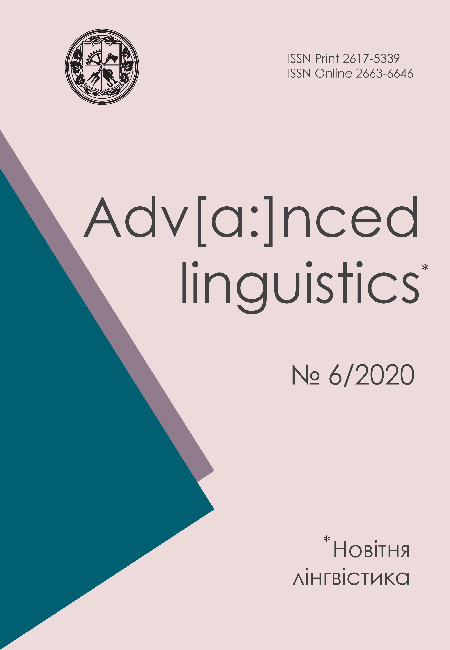PRAGMALINGUISTIC FEATURES OF TELESCOPIC UNITS’ REPRODUCTION IN MEDIA TEXTS WHEN TRANSLATED FROM ENGLISH INTO UKRAINIAN
DOI:
https://doi.org/10.20535/2617-5339.2020.6.216376Ключові слова:
telescopy, word formation, formation models, blends, media discourse, contamination, translation methods and strategies.Анотація
A new area of research in modern linguistics is a variety of media resources, including the global Internet, which is not only the information accumulation environment, but also the source of new language units’ emergence from various fields of science and technology, human life and work. The peculiarity of vocabulary development and enrichment is the developed ability of national languages to express the unknown through the known, to denote the new with the help of existing signs. One of such ways of word “creative” formation is the telescopy, or contamination. This article focuses on the study of such linguistic phenomenon as a “telescopic unit” in the media discourse. The authors begin the study with the general overview of the main features, typology and characteristicsof telescopic units, or blends. In addition, they describe blends’ main formation models. At the same time, special attention is paid to the main translation methods of telescopic units, their peculiarities and differences. The research paper also presents the various blends’ translation techniques and strategies, key tips essential to ensure the most exact and adequate transition of English telescopic units into Ukrainian. Given the variety of ways to form blends, the diversity of their meanings and expressive connotation, it is often difficult to find an appropriate translation method for further adequate decoding. And the actual lack of telescopic units’ dictionaries increases the need for further study of the sources and formation mechanisms of these neologisms for their more accurate translation. The study encourages the idea of further research in the sphere of a contamination phenomenon. The results of this study can assist any interpreter in adequate telescopic units’ translation.
Посилання
Cannon G. (1989). Abbreviations and Acronyms in English Word-Formation. New York. [in English]
Halyshyn І. M. (2011). Teleskopiya yak odyn iz novitnih sposobiv slovotvoru v anhliyskiy movi [Telescopy as one of modern methods of word formation in the English language]. Lutsk. [in Ukrainian]
Holets V.A. (2015). Neologismy v suchasniy anglomovniy molodizniy presi [Neologisms in modern English youth media]. Pyatyhorsk. [in Ukrainian]
Karaban V. (2001). Pereklad anhliyskoyi naukovoyi tehnichnoyi literatury [Translation of English scientific technical literarure]. Vinnytsia. [in Ukrainian]
Kemmer S. (2000). Schemas and lexical blends. Essen. [in English]
Klymenko O. L. (1999). Popovnennia slovnykovoho skladu suchasnoyi anhliyskoyi movy z neliteraturnych pidsystem [Increasing of word composition of the modern English language]. Zaporizhzhia. [in Ukrainian]
Kruts L. B., Omeltchenko L.F. (2003). Teleskopiyni slova suchasnoyi anhliyskoyi movy ta jich strukturno-semantychna harakterystyka [ Telescopic units of the modern English language and their structural-semantic characteristics]. Lviv. [in Ukrainian]
Mattiello E. (2008). An Introduction to English Slang: A description of its Morphology, Semantics and Sociology. Monza. [in English]
Soudek L. (1978). The Relation of Blending to English Word Formation: Theory, Structure and Typological Attemps. Innsbruck. [in English]
Tomaszewicz E. (2008). Novel words with final combining forms in English. A case for blends in word formation. Poznan. [in Polish]
Turchak О.M. (2005). Okazionalizmy v movi ukrayinskoyi presy 90-h rokiv ХХ stolittia [Occasionalisms in the language of Ukrainian media in the 90’s of the 20th century]. Dnipro. [in Ukrainian]
Yenikieyeva S. М. (1999). Formuvannia tа fukcionuvannia novych slovotvorchych elementiv anhliyskoyi movy [Formation and functioning of the new word-formation elements of the English language]. Zaporizhzhia. [in Ukrainian]
Zatsnyj Yu. А., Yankov А.V. (2010). Nova rozmova leksyka і fraseolohiya [New colloquial vocabulary and phraseology]. Vinnytsia. [in Ukrainian]
Zatsnyj Yu. А. (1997). Neolohismy anhliyskoyi movy 80-90 rokiv ХХ stolittia [Neologisms of the English language in the 80-90’s of 20th century]. Zaporizhzhia. [in Ukrainian]
Zatsnyj Yu. А., Pachomova Т.О. (2001). Mova і suspilstvo: zbahachennia slovnykovoho skladu suchasnoyi anhliyskoyi movy [Language and community: enrichment of the vocabulary of the modern English language]. Zaporizhzhia. [in Ukrainian]
##submission.downloads##
Опубліковано
Номер
Розділ
Ліцензія
Наше видання використовує положення про авторські права CREATIVE COMMONS для журналів відкритого доступу.
Автори, які публікуються у цьому журналі, погоджуються з наступними умовами:
1. Автори залишають за собою право на авторство своєї роботи та передають журналу право першої публікації цієї роботи на умовах ліцензії Creative Commons Attribution License, котра дозволяє іншим особам вільно розповсюджувати опубліковану роботу з обов'язковим посиланням на авторів оригінальної роботи та першу публікацію роботи у цьому журналі.
2. Автори мають право укладати самостійні додаткові угоди щодо неексклюзивного розповсюдження роботи у тому вигляді, в якому вона була опублікована цим журналом (наприклад, розміщувати роботу в електронному сховищі установи або публікувати у складі монографії), за умови збереження посилання на першу публікацію роботи у цьому журналі.

